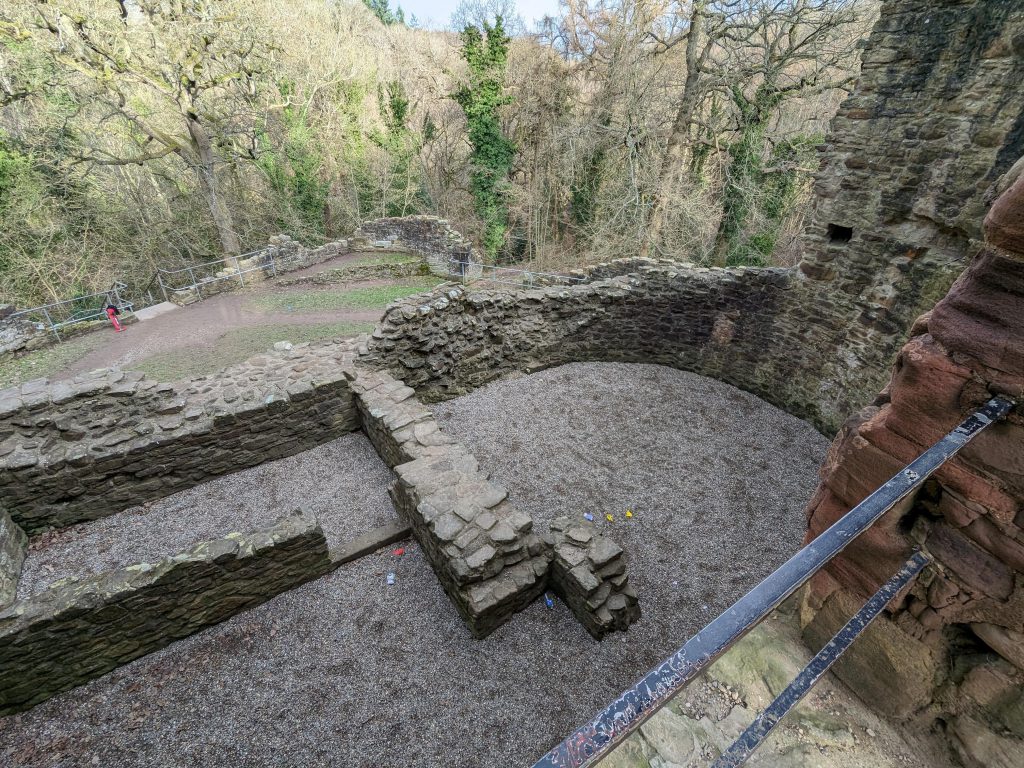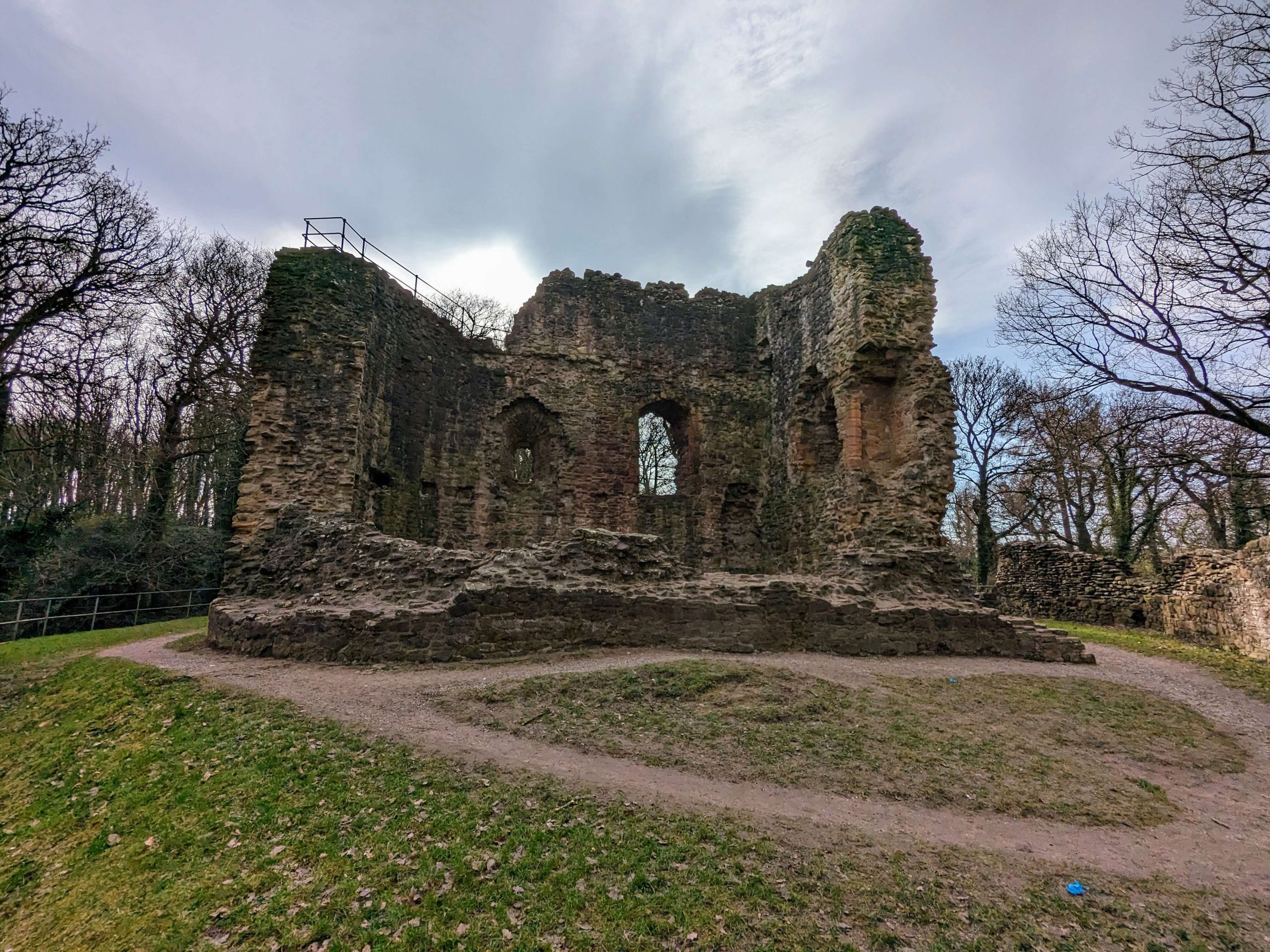Situated in Flintshire, Wales, Ewloe castle is really a rather unique and mysterious castle. There is very little documentary evidence to tell us the castle’s story and its location is most unusual as it does not appear to hold any strategic vantage point, it is located deep within ancient woodland.
| Built | 13th Century |
| Type | Motte and Bailey |
| Condition | Ruinous – Major Stonework Intact |
| Ownership | Cadw |
| Access | Public – Admission Free |
| Postcode | CH5 3BZ |
Click here to watch our video exploring Ewloe Castle and discover its history
When was Ewloe Castle built?
When Ewloe Castle was built is still debated by historians. It was originally thought to have been built by Llywelyn ap Gruffudd (Llywelyn the Last) in around 1257. Other historians have put forward an argument though that its construction was much earlier and it may have been Llywelyn’s grandfather, Llywelyn ap Iorwerth (Lywelyn the Great) who built it earlier in the 13th century.
The argument does not end here, there is further debate regarding whether there was an earlier fortification on the site.
Why Did They Build A Castle In The Middle Of The Woods?
The next question is why did they build a castle on a site that seems to have no strategic advantage. The answer may come from a battle that was fought in these woods. In July 1157, King Henry II led an immense army into Wales with the objective of defeating Owain ap Gruffudd. Accompanied by 30,000 men, Henry’s destination was Rhuddlan Castle. However, Owain, with his comparatively smaller force, strategically camped at Basingwerk, obstructing Henry’s army along their route.
Facing this challenge, Henry opted to lead a portion of his men through Ewloe woods, hoping to outmanoeuvre the Welsh. In a well-executed ambush, Owain and his forces engaged Henry in what is now known as the Battle of Ewloe (also referred to as the Battle of Coleshill). Emerging victorious, Owain dealt a significant blow, and Henry narrowly escaped with his life. This was a great victory for the Welsh and from this we could assume that Ewloe castle was possibly built to celebrate Welsh strength.
Supporting the argument for the existence of a fortification at Ewloe prior to the era of Llywelyn the Last is the context of the legal disputes over control of the Mold marcher lordship in the early 1240s. These disputes involved Dafydd ap Llywelyn, son of Llywelyn, and representatives of Henry III of England. The meetings for these negotiations are reported to have taken place at ‘Wapir’ forest, with Ewloe situated in Wapre forest. This suggests the presence of a building at Ewloe deemed prestigious enough to host such discussions.
Regrettably, these negotiations proved unsuccessful and eventually led to a war between 1244 and 1246. Following Dafydd ap Llywelyn’s defeat, it seems that the Welsh abandoned Ewloe when English authority was reinstated in this northeastern part of Wales.


Ewloe was reclaimed and refurbished by Llywelyn ap Gruffudd (Llywelyn the Last) during his military reconquest of the Perfeddwlad in 1256–57. Given the substantial military expenses incurred by Llywelyn during the conflict with the English, it appears more plausible that he chose to renovate Ewloe rather than embark on the construction of a new structure. Once again, Ewloe played a crucial role as the backdrop for diplomatic negotiations between the Welsh and the English in both 1259 and 1260.
In 1276, Edward I initiated his conquest of Wales, leading his forces out of the castle at Chester and advancing up the west coast of the Dee Estuary. Upon establishing an advanced base at Flint, situated a day’s travel from Chester, construction promptly commenced on Flint Castle. Although there is no mention of Ewloe in the war chronicles of 1276–77, the presence of what appears to be a siegework outside the castle suggests the possibility of a siege. Ewloe, however, held little military value for Edward I, as his strategically positioned castles at Flint and Rhuddlan could be easily supplied with provisions by sea.
The final contemporary references to Ewloe Castle are found in the Chester Plea Rolls, which detail a report sent by the Justice of Chester to Edward II in 1311 regarding the history of the manor at Ewloe from the mid-12th century. According to the rolls, by 1257, Llywelyn ap Gruffudd had regained control of Ewloe from the English and had ‘strengthened’ a castle in the woods. The report in 1311 stated that much of the castle was still standing.
However, by the late medieval period, the castle had fallen into ruin. A significant portion of its dressed stonework from curtain walls and the keep had been dismantled and repurposed for construction materials in and around Mold and Connah’s Quay.


Ewloe Castle Layout
The mysteries of Ewloe Castle do not stop with its history, its layout is quite perplexing also. The castle has two courtyards with no gate connecting them, they were both accessed by separate gates on the north side. One theory why the castle is constructed in this manner is that the courtyards may have been built in two separate phases and even that they had separate purposes or households.
The inner ward features a D-shaped keep positioned atop a motte in close proximity to the parapet curtain wall, and access to the tower would have been granted through the first floor. The outer walls of the tower, measuring 2 metres (6 feet 7 inches) at their base, ascended to a height of approximately 11 metres (36 feet). This elevation surpassed the upper storey, providing added protection to the pitched roof against projectiles. A parapet encircled the tower’s summit, and openings in the stonework indicated the placement of storage slots in the upper roof spaces.
The tower comprised a sole first-floor hall situated above a lower ground floor chamber. Defensive arrow slits adorned the curved sides of the tower, enhancing its defensive capabilities. On the flat side, which overlooked the outer ward, a Romanesque window added a distinctive architectural feature to the structure. What is unusual about this keep is that most D-shaped towers protrude from the curtain wall rather than standing alone.
The lower outer ward is surrounded by two distinct sections of wall that converge at a circular fortified tower situated on a rocky knoll. Within this ward, there is a well located just outside the tower, and it likely accommodated several timber buildings as well.


Haunted Ewloe Castle
Ewloe Castle and the encompassing parkland are reputed to be a hotspot for paranormal activity, garnering attention from paranormal investigator television programs. Paranormal sightings range from a floating nun named Nora, a pack of spirit dogs, and a singing woman, to the eerie presence of a phantom army accompanied by a headless horseman.
The most renowned ghost associated with Ewloe Castle is Nora the Nun, and various stories surround her mysterious tale. One narrative suggests that Nora, burdened by the shame of giving birth to an illegitimate child, tragically took the infant’s life by throwing it from the top of the highest turret. Upon being witnessed by castle guards, she faced trial and was purportedly bricked up alive within a castle wall as punishment.
Other accounts propose alternative fates for Nora, such as an illicit affair with a monk that allegedly led to her beheading, or her drowning in the Rosie pond after dropping her illegitimate child into the water. Yet another version suggests Nora met her end near the waterfall where she was last spotted, possibly struck by a bomb. The various stories contribute to the mystique surrounding Nora the Nun and her spectral presence at Ewloe Castle.
Another intriguing aspect of the paranormal lore surrounding Ewloe Castle involves accounts from those who venture to the castle late at night during stormy weather. According to these tales, individuals have reported hearing the distinct sounds of drumming and the marching of an army. Some even claim to have felt the phantom gusts of wind attributed to passing horses. These eerie occurrences add to the mysterious and haunting reputation of Ewloe Castle, making it a site of both historical significance and spectral fascination.
Click below to explore Ewloe Castle with us

